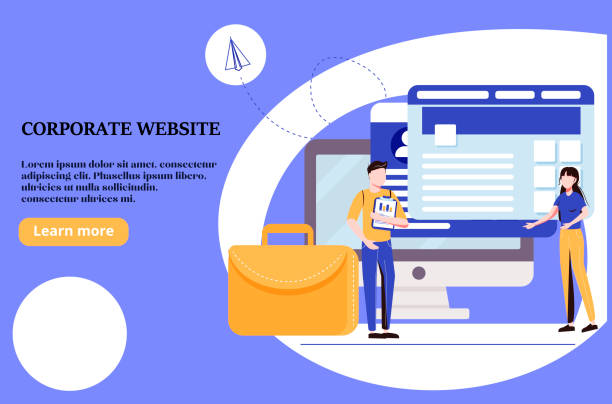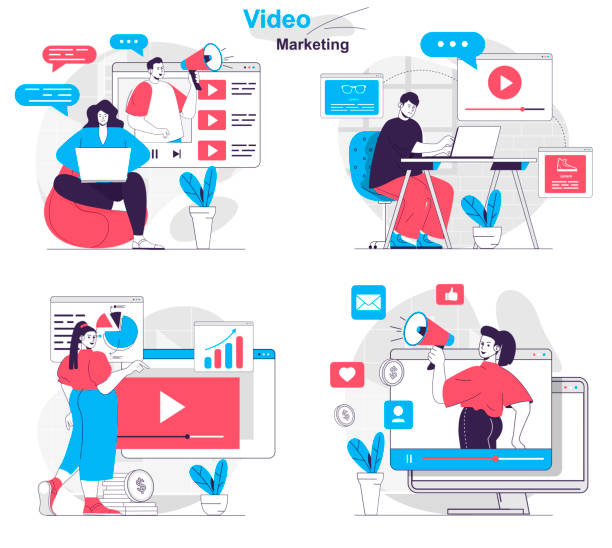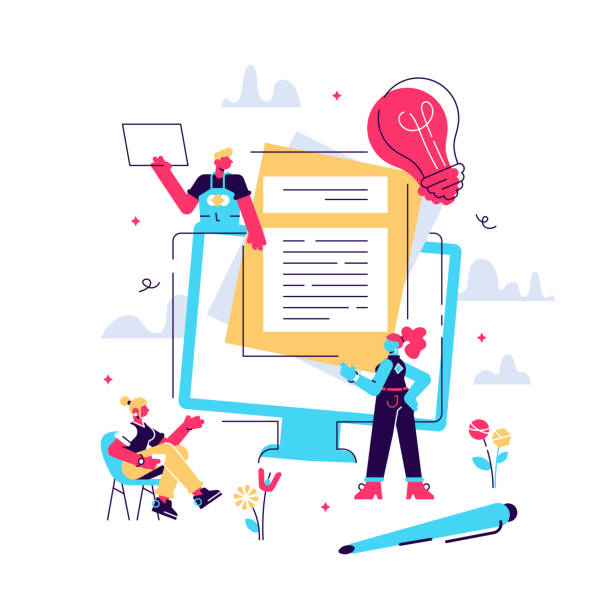Why is Fast Website Design a Necessity Today?

In today’s digital world, website speed is not just an advantage, but a vital necessity for online success.
Every second of delay in page loading can mean losing potential users and customers.
Research shows that most users expect a website to load in less than three seconds, and if it doesn’t, they quickly leave the page.
This phenomenon, which leads to a high Bounce Rate, directly impacts SEO optimization and your ranking in search results.
Search engines like Google consider loading speed as a critical ranking factor.
Therefore, fast website design plays a central role in visibility, audience engagement, and ultimately, a positive user experience (UX).
For businesses, website speed’s importance goes beyond a technical factor; it is directly linked to profitability and brand reputation.
A slow website can lead to a decrease in conversion rate, customer dissatisfaction, and ultimately, loss of revenue.
Conversely, a fast-loading website not only satisfies users but also encourages them to spend more time on the site and interact with your content.
This, in turn, helps to improve search engine rankings and increase organic traffic.
#ReduceBounceRate #IncreaseTraffic #SEOFactor #ImproveUserExperience
This is vital not only for e-commerce websites but also for blogs, news websites, and any online platform that relies on user interaction.
The goal of high-performance website development is to provide the best possible experience to visitors, regardless of their device or internet speed.
Investing in fast website design is, in fact, an investment in the future of your online business.
Is your online sales not meeting expectations? With Rasaweb, permanently solve the problem of low sales and poor user experience!
✅ Increase visitor-to-customer conversion rate
✅ Create an enjoyable user experience and boost customer trust
⚡ Act now for a free consultation!
Key Factors Affecting Website Speed

To achieve fast website design, understanding the factors affecting its speed is crucial.
The overall page size is one of the most important factors; the more images, videos, fonts, and code on a page, the longer its loading time will be.
The size of CSS and JavaScript files also plays a significant role.
If these files are not properly optimized or are too numerous, they can severely reduce loading speed.
The number of HTTP requests that the browser sends to the server to load a page is another important factor.
Each image, CSS file, JavaScript file, and font creates a separate request.
Reducing these requests by combining files or using Sprites for images can have a dramatic impact on speed.
Server Response Time is also a key factor.
If your server is slow or not properly configured, even with an optimized website, the loading time will be long.
Choosing appropriate hosting and using optimized server technologies like SSD and HTTP/2 can minimize this time.
Database optimization, using lightweight content management systems, and removing unnecessary plugins in CMSs like WordPress, all help reduce server load and increase loading speed.
Building a fast website requires attention to all these technical details.
#PageSize #HTTPRequests #ServerResponseTime #DatabaseOptimization
Another aspect is using caching.
Caching allows browsers to store parts of the website for subsequent visits, which dramatically increases loading speed for returning users.
These factors, together, provide a complete picture of the complexities and requirements of website speed optimization.
Modern Tools and Techniques for Fast Website Design

Achieving fast website design requires the use of modern tools and techniques.
One of the most important techniques is Gzip compression, which significantly reduces the size of CSS, JavaScript, and HTML files, thereby increasing the data transfer speed from the server to the browser.
Minification of CSS and JavaScript files by removing white spaces, comments, and extra characters also helps reduce size and improve speed.
Using server-side and browser-side caching prevents the repetitive loading of resources that have been downloaded before.
This is especially beneficial for returning users and significantly improves the user experience.
Technologies like AMP (Accelerated Mobile Pages) for mobile pages and Service Workers for building offline experiences and improving re-load speed, are other powerful tools in high-performance website development.
Choosing lightweight and efficient frameworks like React, Vue, or Svelte instead of heavier ones can help reduce code size and increase speed.
Also, implementing Lazy Loading for images and videos (loading them only when the user scrolls to that part of the page) significantly lightens the initial page load.
#Compression #Caching #AMP #LazyLoading
For continuous monitoring and optimization, tools like Google PageSpeed Insights, GTmetrix, and Pingdom Tools are very useful.
These tools identify weaknesses in your website and provide suggestions for speed improvement.
Fast website design is a continuous process, and using these tools for regular monitoring is essential.
| Optimization Technique | Description | Impact on Speed |
|---|---|---|
| Gzip Compression | Reduces the size of text files (CSS, JS, HTML) | Very High |
| Minification | Removes extra spaces and comments from code | High |
| Browser Caching | Stores website resources in the user’s browser | Very High (for repeat visits) |
| Lazy Loading | Loads images and videos only when needed | High (reduces initial load) |
| Using CDN | Distributes content from the nearest server | Very High (for global users) |
Optimizing Images and Media for More Speed

Images and media often constitute the largest share of a web page’s size and can significantly impact loading time.
Therefore, optimizing images and media is one of the essential steps in fast website design.
The first step is choosing the correct image format.
For photos, JPEG is often the best option as it provides good compression with minimal quality loss.
For images with transparency or simple graphics, PNG is more suitable.
Newer formats like WebP can also significantly reduce file size while maintaining visual quality.
After choosing the format, compressing images without noticeable quality loss (lossless compression) or with minimal quality loss (lossy compression) is essential.
Various online tools and software like TinyPNG or Compressor.io can help you with this.
Also, ensure that image dimensions are appropriate for the space they occupy on your website; loading a 4000-pixel image in a space that is only 800 pixels wide means wasting bandwidth and loading time.
Implementing Lazy Loading for images and videos is a very effective technique for building a fast website.
With this method, images are loaded only when the user scrolls to the relevant section of the page, which significantly lightens the initial page load.
For videos, instead of hosting them directly on your server, use platforms like YouTube or Vimeo.
These platforms perform the necessary optimizations for video playback and offload the burden from your server.
Also, using lower quality videos for initial display and offering a higher quality option can help improve speed.
#ImageOptimization #ImageFormats #ImageCompression #LazyLoadingImages
Remember that fast website design includes paying attention to small details such as optimizing icons (using SVG instead of PNG) and fonts (only loading necessary weights and styles).
Does your current e-commerce website design not generate the expected sales?
Rasaweb specializes in professional e-commerce website design!
✅ An attractive and user-friendly site aimed at increasing sales
✅ High speed and security for an ideal shopping experience⚡ Get a free consultation on online store design with Rasaweb!
The Role of Optimized Coding in Fast Page Loading

One of the main pillars of fast website design is optimized and clean coding.
Messy, repetitive, or unnecessary code can severely impact website performance.
Initially, reducing the number of HTTP requests by combining CSS and JavaScript files into one, or using Sprites for icons, is a crucial step.
Also, Minification of these files, which includes removing white spaces, comments, and extra characters, reduces their size and improves loading speed.
The placement of CSS and JavaScript code in the HTML document also matters.
CSS code should be placed in the <head> section so that the browser can render the page style faster, while JavaScript code should be loaded at the end of the <body> tag or using the defer or async attributes.
This allows the browser to display the main content of the page before loading the scripts, which helps to increase perceived performance.
Optimizing the DOM (Document Object Model) by maintaining a simple and efficient structure can prevent unnecessary complexities and long rendering times.
Removing nested HTML elements and using CSS for layout instead of nested tables helps improve performance.
#CleanCoding #DOMOptimization #CSS_JSFiles #AsynchronousJavaScript
Using lightweight frameworks and libraries that only load necessary code prevents loading the entire library.
For example, if you only need a specific part of a JavaScript library, use tree-shaking to remove unnecessary code.
This approach greatly contributes to high-performance website development.
All these tips ultimately lead to building a fast and efficient website.
Choosing Suitable Hosting and CDN’s Impact on Speed

Choosing suitable hosting is one of the most important decisions on the path to fast website design.
Even if your website is optimized to the best extent, unsuitable hosting can negate all your efforts.
Server response time, bandwidth, and server hardware resources (such as using SSD instead of HDD) all directly impact loading time.
Cloud Hosting and Virtual Private Servers (VPS) are often better options than shared hosting for websites with medium to high traffic, as they provide dedicated resources and greater scalability.
The geographical location of the server is also very important.
If most of your users are in a specific region, choosing a server close to that region reduces latency and improves loading speed.
In addition to hosting, using a Content Delivery Network (CDN) can have a dramatic impact on your website’s speed.
A CDN consists of a network of servers around the world that store cached versions of your website’s static content (such as images, CSS, and JavaScript).
When a user visits your website, the CDN delivers the content from the server closest to them, which significantly reduces loading time, especially for users accessing your website from far distances.
A CDN can also protect against DDoS attacks and offload traffic from your main server, which helps with your website’s stability and better performance.
For any website aiming for high-speed loading websites for a global audience, using a CDN is an essential investment.
#SSDHosting #CloudHosting #CDN #ServerLocation
In summary, combining a powerful and optimized hosting with an efficient CDN is a comprehensive solution to ensure fast website design and provide the best experience to users worldwide.
Responsive Design and Mobile Loading Speed

In today’s world, where mobile internet usage is increasing, Responsive Design is no longer an option, but a necessity.
However, just being responsive is not enough; mobile loading speed is equally important.
Mobile users often have slower or less stable internet access, so every millisecond of delay can mean losing them.
Google, with the introduction of Core Web Vitals, has emphasized the importance of user experience, including loading speed and visual stability on mobile devices.
Achieving good scores in these metrics is crucial for SEO ranking.
To improve mobile speed, in addition to general optimization techniques, a few key points should be considered.
Implementing a Mobile-First approach in design and development means first designing and optimizing for mobile devices, then extending it to desktop pages.
This approach helps you focus on low size and optimal performance from the outset.
#ResponsiveDesign #MobileSpeed #MobileFirst #CoreWebVitals
Optimizing images for mobile is very important; use smaller dimensions and more compression, and use the srcset and <picture> attributes in HTML to deliver images with appropriate resolution for each device.
Also, reducing HTTP requests, efficient use of web fonts, and eliminating render-blocking JavaScript are other important steps for fast website design on mobile.
These actions help you have high-speed loading websites suitable for all devices.
| Core Web Vitals Metric | Explanation | Goal (Example) |
|---|---|---|
| LCP (Largest Contentful Paint) | Time to load the largest content element on the page | Under 2.5 seconds |
| FID (First Input Delay) | Site’s response time to the user’s first interaction | Under 100 milliseconds |
| CLS (Cumulative Layout Shift) | Visual stability of the page during loading | Under 0.1 |
| TTFB (Time To First Byte) | Time until the first byte is received from the server | As low as possible |
| FCP (First Contentful Paint) | Time until the first content element is displayed | Under 1.8 seconds |
Better User Experience with an Exceptionally Fast Website

Website speed is not just a technical factor, but a vital element in shaping the user experience (UX).
A website that loads quickly directly impacts user satisfaction and loyalty.
Today’s users are more impatient than ever; waiting for a long load can quickly drive them away from your site and towards competitors.
Therefore, fast website design is more than a feature, it’s a competitive advantage.
A fast website conveys a sense of professionalism and credibility to the user.
When pages open quickly, users feel that your website is reliable and efficient, which in turn leads to increased brand trust and an improved brand image for your business.
This positive feeling can significantly increase conversion rates, whether your goal is to sell products, generate leads, or increase visit time.
In addition to deterring users, slow websites can also lead to decreased SEO rankings.
Google places great importance on user experience, and loading speed is one of its primary criteria.
Therefore, a slow website not only loses users but also appears less frequently in search results.
Speed optimization can also reduce your operational costs.
Faster and more optimized servers consume fewer resources, which can lead to reduced hosting costs.
Ultimately, building a fast website is an investment in the future that pays off in the form of satisfied users, increased sales, and improved brand position.
#UserSatisfaction #ConversionRate #Branding #MobileSEO
Focusing on fast website design demonstrates your respect for user time and your commitment to providing the best possible experience, which in itself is a successful strategy in today’s competitive market.
Did you know that 94% of a company’s first impression relates to its website design?
Rasaweb, by offering professional corporate website design services, helps you create the best first impression.
✅ Create a professional and trustworthy image of your brand
✅ Easier attraction of potential customers and improved online standing
⚡ Get a free consultation on corporate website design!
Case Study of Successful Fast Website Design

To gain a deeper understanding of the benefits of fast website design, examining successful cases can be very insightful.
One prominent example is large e-commerce websites like Amazon or Walmart.
These companies have invested millions of dollars in optimizing their site speed, and every millisecond of improvement in loading speed translates to millions of dollars in increased profit for them.
Case studies have shown that even a 100-millisecond reduction in loading time can increase the conversion rate by up to 1%.
On a large scale, these are enormous figures.
As another example, news platforms like BBC News or The New York Times also heavily focus on their website speed.
Fast loading speed for these sites means retaining readers’ attention in the fast-paced world of news.
They use techniques like AMP (Accelerated Mobile Pages) and advanced content compression to ensure instant loading of articles on mobile devices.
One less-known successful project in high-performance website development might relate to a tech startup that, by reducing its homepage loading time from 5 seconds to 1.5 seconds, managed to increase user sign-up rates by 15%.
They achieved this success by database optimization, image compression, and selecting appropriate hosting.
#CaseStudy #ContinuousOptimization #PerformanceMonitoring
These examples show that regardless of business size and type, fast website design is a critical factor for success.
They continuously monitor their website performance and make decisions based on data.
High-speed loading websites not only help achieve business goals but also provide a positive user experience for visitors.
The Future of Web Design and the Importance of Sustainable Speed

The future of web design is strongly linked to the concept of sustainable speed.
With technological advancements and increasing user expectations, website loading speed will transform from a good feature to an essential need.
Future trends such as Web3, increased use of AI and augmented reality in websites, all require platforms with exceptionally high performance.
Continuous Performance Optimization will become an integral part of the web development lifecycle.
This means that developers and designers must constantly test new tools, review their code, and optimize their system architectures to maintain high speed and responsiveness in the face of richer content and more complex interactions.
#Web3 #ArtificialIntelligence #SustainableSpeed #ContinuousPerformance
The importance of Core Web Vitals will also increase, and search engines will apply stricter criteria for ranking websites.
This puts more pressure on developers to prioritize speed at the core of their fast website design from the very beginning.
Technologies like HTTP/3 and network protocol improvements, along with advancements in JavaScript frameworks and bundling tools, will further help reduce loading times.
However, even with these advancements, the need for a comprehensive optimization approach that includes image optimization, clean coding, and appropriate hosting will remain.
Ultimately, success in the future of the web depends on our ability to create high-speed loading websites and provide seamless user experiences, regardless of the user’s device or internet connection.
This is an ongoing challenge that can be overcome with a commitment to fast website design.
Frequently Asked Questions
| Number | Question | Answer |
|---|---|---|
| 1 | What is the concept of “Fast Website Design”? | Designing a website that loads in the shortest possible time and provides a smooth user experience, with an emphasis on performance optimization. |
| 2 | Why is website loading speed important for users? | Today’s users have little patience; slow sites lead to early page abandonment, poor user experience, and loss of visitors. |
| 3 | How does fast website design impact SEO? | Search engines like Google consider site speed as one of the ranking factors. Faster sites achieve better rankings in search results. |
| 4 | What are the main factors affecting site speed? | Image optimization, caching, CSS and JS file compression, using powerful hosting, reducing HTTP requests, and optimized coding. |
| 5 | How can website loading speed be measured? | Using tools like Google PageSpeed Insights, GTmetrix, Lighthouse, and Pingdom Tools which provide detailed reports on site performance. |
| 6 | What is the role of images in site speed and how should they be optimized? | High-volume images can severely reduce site speed. They should be compressed, modern formats (like WebP) should be used, and Lazy Load technique should be employed. |
| 7 | What is the importance of choosing suitable hosting in fast website design? | Powerful and high-speed hosting (preferably SSD) with optimized servers close to target users is the foundation of a site’s speed. |
| 8 | How does Caching help increase website speed? | Caching allows the user’s browser to store versions of site files, so on subsequent visits, there is no need to reload all content, and the site displays faster. |
| 9 | Is using a CDN (Content Delivery Network) recommended in fast website design? | Yes, CDN significantly increases loading speed by storing copies of site content on various geographical servers and delivering it from the closest server to the user. |
| 10 | What are the key tips for developers to design a high-speed website? | Writing clean and optimized code, minimizing plugin usage, optimizing database queries, using lightweight frameworks, and implementing Lazy Load for content. |
And other services of Rasa Web Advertising Agency in the field of advertising
Smart Content Strategy: A professional solution to increase sales with a focus on SEO-driven content strategy.
Smart Google Ads: An effective tool to improve SEO ranking with the help of SEO-driven content strategy.
Smart Brand Identity: A novel service to increase click-through rates through precise audience targeting.
Smart Link Building: A novel service to enhance campaign management through marketing automation.
Smart Advertorial: A professional solution to increase click-through rates by focusing on attractive user interface design.
And over hundreds of other services in the field of internet advertising, advertising consultation, and organizational solutions
Internet Advertising | Advertising Strategy | Advertorial
Sources
- Website Speed Optimization
- Principles of Responsive Website Design
- Increase Website Loading Speed with Google’s Recommendations
- Website Performance Optimization Training
? Are you ready to revolutionize your business in the digital world? Rasaweb Digital Marketing Agency, by providing comprehensive SEO solutions, content marketing, and personal website design, is your strategic partner in achieving sustainable success.
📍 Tehran, Mirdamad Street, next to Bank Markazi, Kazerun Jonubi Alley, Ramin Alley, No. 6




